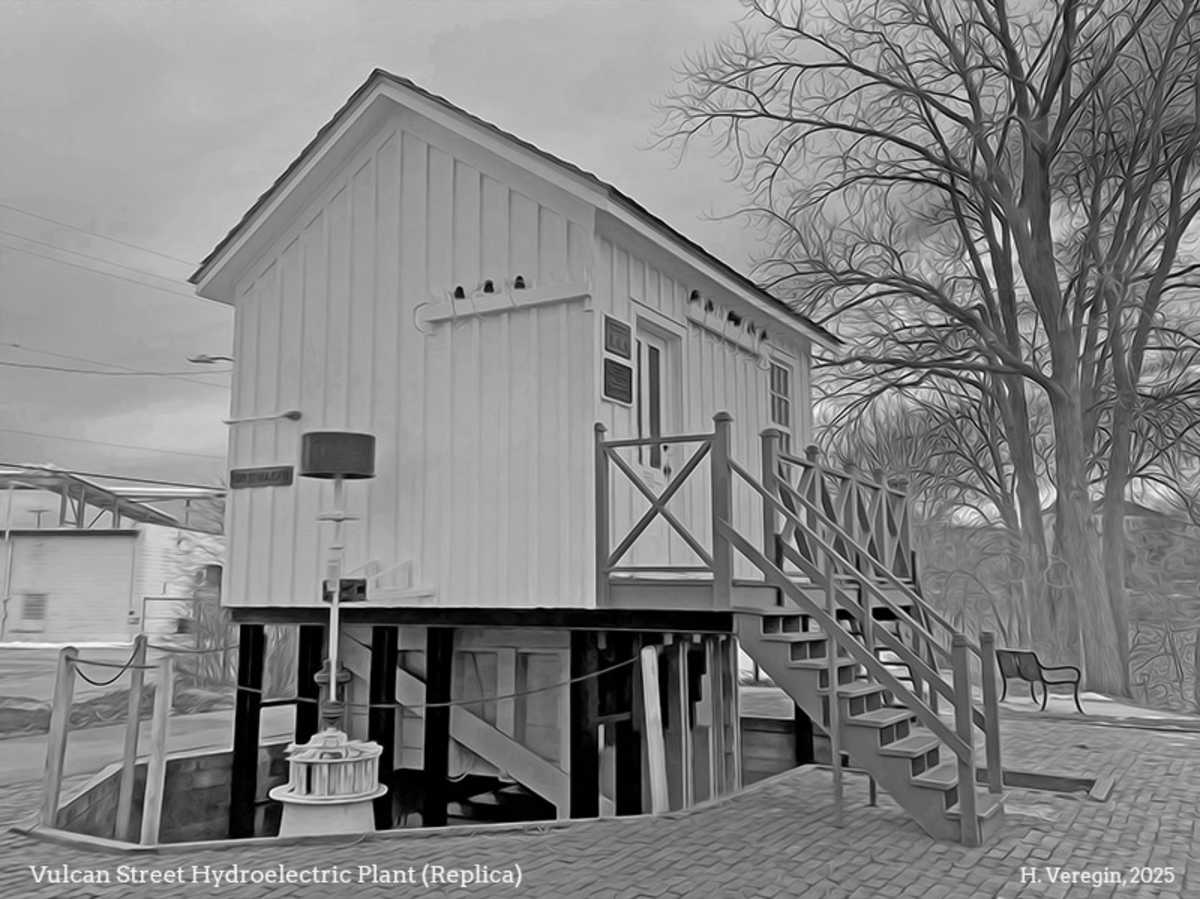Oddsconsin...where we explore peculiar and sometimes mysterious features of Wisconsin’s human landscape.
The Vulcan Street Hydroelectric Plant in Appleton, which opened in 1882, was one of the first commercial hydroelectric plants in the US, and one of the few to utilize Thomas Edison’s direct current generators. Edison ultimately failed to make direct current power generation a commercial success, due to the overwhelming advantages of alternating current. Edison’s battle with proponents of alternating current, including Nikola Tesla, is part of a larger story with connections to development of the electric chair as a supposedly more humane method of capital punishment.
Today, a 1932 replica of a portion of the Vulcan Plant sits on the south bank of the Fox River (on what was once known as Grand Chute Island) just to the west of South Lawe St. This is evidently not the original location. Historic Sanborn maps, a product of the 19th century fire insurance industry, show the plant west of South Olde Oneida St., then known as Lake St., on the north bank of the Fox River Navigation Canal (also known as the Fox River Lock Channel), then known as the US Canal.
The plant appears on the 1886 Sanborn map as the Edison Electric Light Company, a collection of small frame (wooden) buildings with an office, a workshop and four dynamos (generators). The dynamo building has a second floor and basement. A flume (or tail race) stretches behind the plant for a few hundred feet.
The 1891 edition of the map shows a slightly enlarged facility, with the text “Runs Night & Day, No Watchman. Power: Water. Heat: Stoves. Fuel: Coal. Lights: Elec. No Fire App.” A horse shed has been added to the east of the plant, possibly to haul coal for heating. By 1901, the plant, now called the Edison Appleton Electric Light and Power Company, has expanded in size to include five generators, with “Two Men on Duty Day and Night.”
On the 1911 map, the plant has been subsumed within a much larger brick structure, called the Riverside Fibre and Paper Company. The original plant buildings survive, but have been converted to other uses, such as storage.
This history corresponds to the dates on the various plaques outside the 1932 replica, although these plaques disagree about the historical significance of the plant. A plaque placed in 1933 by the Appleton Chapter of the Daughters of the American Revolution states that the plant was the “World’s First Hydro-Electric Central Station.” A plaque donated by the Parish family in 1979 qualifies this statement by adding it was the first “Edison” hydroelectric system.
The 2014 Wisconsin Historical Society plaque adds further context, calling it “perhaps one of the earliest examples of a hydroelectric plant that sold electricity commercially.” The plant was small, and lit only a few homes and mills in Appleton (with Edison light bulbs of course).
Edison was a pioneer of electrical power, and the Vulcan Plant in Appleton was not his first hydroelectric project. In 1881, he connected a dynamo to a turbine in a flour mill in the city of Niagara Falls, New York, to provide street lighting for the city.
The problem with Edison’s plants was that they generated direct current. The real breakthrough in commercial electricity generation came in 1893, with the development of the first alternating current hydroelectric plant in Redlands, California. The comparative advantage of alternating current is that it can be transmitted longer distances by stepping up the current tens of thousands of volts.
The failure of Edison’s 1880s Pearl Street Plant in New York City, which used coal rather than water power, showed decisively the limitations of direct current for large-scale electricity generation. Edison, however, was not deterred. His opponents, who included Tesla (a one-time employee of Edison) and George Westinghouse, were advocates of alternating current, which would ultimately prevail.
Edison’s criticism of alternating current – that it is dangerous – is based in fact. However, in his effort to discredit alternating current, he resorted to the macabre tactic of publicly electrocuting animals to demonstrate the danger of alternating current. Beginning in 1888, Edison’s team killed forty-four dogs, six calves and two horses in their demonstrations.
Edison’s bizarre antics did not save direct current, but they did help usher in the electric chair to execute prisoners who had been sentenced to death. In 1886, New York State established a commission to identify a form of capital punishment that was more humane than hanging. The electric chair had actually been developed some years earlier, by a dentist. But Edison’s animal electrocution experiments helped sway the commission, and the state of New York made death by electrocution legal in 1888.
Edison seemed to feel the new form of capital punishment proved his point about alternating current, suggesting that prisoners thus executed should be called “Westinghoused” rather than “electrocuted.”
The first use of the electric chair took place at Auburn Prison in New York’s Finger Lakes region in 1890. The execution of convicted killer William Kemmler did not go as planned. The first charge, 17 seconds at 1000 volts, was insufficient to kill Kemmler, so a second charge of 2000 volts was administered. The description of the effects on Kemmler’s body is shocking.
Even small buildings, like the Vulcan Street Hydroelectric Plant in Appleton, can sometimes hold a lot of history.
